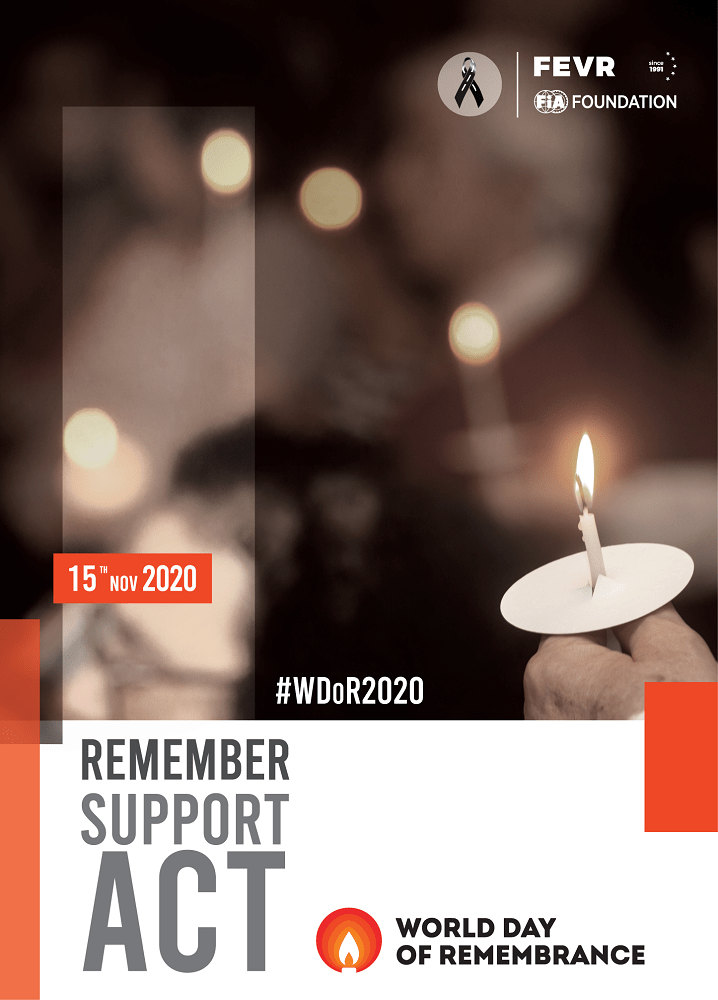SABRINA - WORLD DAY OF REMEMBRANCE 2020
12-11-2020
Miro (76) from Slovenia went for a leisurely bike ride after lunch on a sunny day at the end of April back in 2008. He took a circular route from his home, the same one as so many times before. The weather was great, birds were singing, the road was not crowded. All of a sudden everything was black. He woke up in the hospital a few hours later. Double arm fracture, broken hip, broken pelvis, severe abdominal bleedings. After a few days filled with uncertainty and in a coma and five weeks in the hospital, he returned home. Doctors found out that his loss of consciousness which resulted in a collision with a car was a consequence of a minor heart attack. Because of his accident, Miro’s left leg is 2 cm shorter which demands a special shoe insole and poles that make walking more comfortable. Cycling causes him fewer problems, so he is still a passionate cyclist. The road where his accident happened, is shared between cyclists, cars, and even trucks and buses, which Miro fears the most. He is happy to be alive and still able to bike. Now, he is choosing mostly roads with separated bike lanes, since in case he crashes, there are fewer chances to get hit also by a car. He just wishes to have more cycling routes with safe cycling infrastructure to choose from.
Darko (51) from Slovenia was unfortunately not so lucky. His Sunday morning bike ride on the first summer day in 2009 ended tragically. He too had his favorite out and back bike ride from his home to a lake which is about 30 km away. He left in full cycling gear early in the morning to be back for a family lunch and to spend the rest of the day with them at home. But he never returned. A 24-year old driver on the way to work did not drive too fast. He was not drunk. The visibility was good. It was just a second of not being completely focused behind the steering wheel and the consequences for Darko were fatal. He left behind his wife and a 21- and 22-years old son and daughter. His wife Alenka and kids are still active and often on the bikes. But the image of the accident and the pain remain. Alenka especially wants to make sure her grandkids will be safe as cyclists and is a strong supporter of better and most importantly safer cycling infrastructure.
Darko is one of the 41,000 cyclists who die in road traffic-related crashes worldwide every year. As they wrote in the latest Cyclists Safety manual published by World Health Organization, “many leave their homes as they would on any normal day – for school, work, worship, or meeting friends – never to return. Millions of more people are injured in road traffic-related crashes while cycling, some of whom become permanently disabled. These incidents cause much suffering and grief, as well as economic hardship for families and loved ones.”

On the third Sunday in November each year (15 November in 2020), we remember all of them and millions of others who have been killed and seriously injured on the world’s roads. We acknowledge the suffering of all affected victims, families, and communities. For the first time, a day dedicated to remembering road traffic victims was observed internationally 25 years ago when it was introduced by the European Federation of Road Traffic Victims (FEVR). In 2005, the United Nations General Assembly adopted a resolution calling for an annual World Day of Remembrance for Road Traffic Victims as an “appropriate acknowledgment for victims of road traffic crashes and their families”. The World Day is now commemorated across all continents by non-governmental organizations advocating for road safety and road victims as well as governments and all related and relevant stakeholders. Road accidents leave scars in many different forms. Therefore, on World Day of Remembrance (WDoR), we pay tribute also to the dedicated emergency crews, police, and medical professionals, who deal daily with the traumatic aftermath of road crashes.
The objectives of the #WDoR2020 are to provide a platform for road traffic victims and their families to:
- remember all people killed and seriously injured on the roads,
- acknowledge the crucial work of the emergency services,
- draw attention to the generally trivial legal response to culpable road deaths and injuries,
- advocate for better support for road traffic victims and victim families,
- promote evidence-based actions to prevent and eventually stop further road traffic deaths and injuries.
In the SABRINA project, we are aware of the fact the human factor is and will remain present when accidents happen. However, a lot can be done also from an infrastructural point of view. We need well designed and well-maintained roads and cycling networks. We have the tools and the knowledge to make the bicycle routes safer, save lives, and reduce trauma on the roads. The goal of the SABRINA project is to help decision-makers to plan, design, and implement safe and sustainable solutions for improved cycling infrastructure in the Danube region and hopefully beyond. It is not enough just to build cycling infrastructure. It needs to be safe.
For Miro, Darko’s family, cyclists, and all the other road users worldwide. So, let’s stop for a while on Sunday, 15th November 2020. Let’s Remember. Support. Act.
![]()



